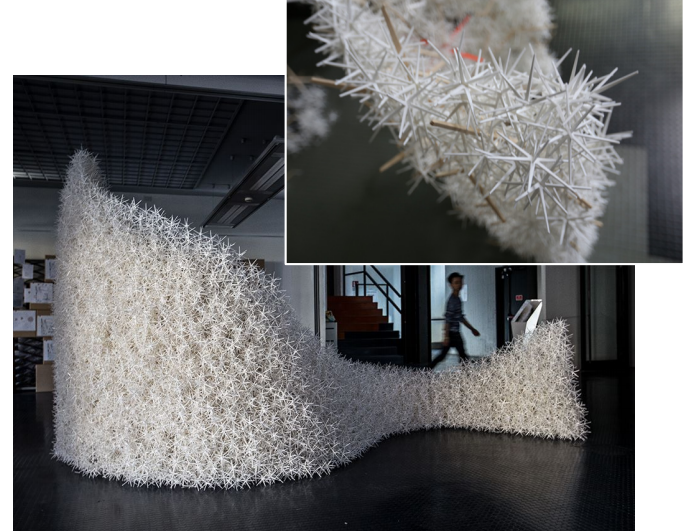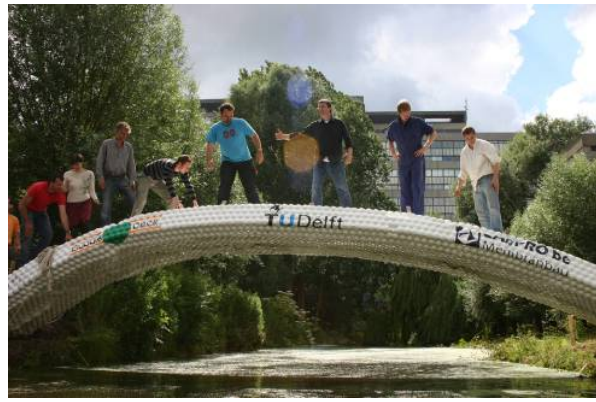How Self-Assembling Granular Materials Are Changing the Future of Architecture
Architecture is a conservative discipline, not least because of the exacting standards of stability and safety that all human-made structures must adhere to. The forces acting on and within any structure must be carefully calculated and the design modified accordingly. Little can be left to chance.

At least, that’s the traditional view. But some designers are toying with another idea—that there’s a different way to build that exploits randomness rather than avoids it. This kind of building will rely on new kinds of granular materials that when tipped into place, bind together in ways that provide structural stability. In this way, walls, columns and even domes could be poured into place, forming complex but stable structures.
That may sound like science fiction but today Sean Keller at the Illinois Institute of Technology in Chicago and Heinrich Jaeger at the University of Chicago explain how this kind of “aleatory architecture” is finally becoming possible. These guys say that the first aleatory structures are already being built and that the approach is introducing new ways to think about architecture and design in general.
First some background. Human have used granular materials such as stones, sand, or earth to build structures for thousands of years. Even today, the technique is common for constructing dams, harbor breakwaters, and gravel beds for railways.
These structures benefit from the special properties of granular materials—their porous nature that allows quick drainage and the fact that they can be poured into place quickly and at low cost.
More interesting is the way they bear loads. Conventional structures require specially designed columns or arches. But granular materials rely on force chains between adjacent particles inside the materials that are set up when the material becomes jammed. At the same time, the material can flow when the jam is released.
There is downside though. The shape of these structures is severely limited by the material’s natural angle of repose. And that also limits the applications.
Much of the properties of granular materials are determined by the shape of the particles from which they are made. This is roughly spherical in many cases.
But in recent years, materials scientists have begun to experiment with particles with more exotic shapes, such as 3-D star shapes, X shapes, hook shapes, and others. When poured, these more easily jam and form stable structures.
That’s led to an entirely new way to think about design. Traditionally, architects have started with the smallest structural components such as columns, arches, walls, and so on and joined them together to form larger structures such as bridges, houses, and skyscrapers.
But the properties of these new granular materials turn this approach on its head. With this stuff, architects can think about the overall form and then work out how it can be achieved by pouring the granular material into place.
One approach is to pour the material into an air-tight fabric container that can be vacuum packed. This generates the pressure that causes the material to jam into more or less any desired shape. A few years ago, engineers at the Technical University of Delft constructed a bridge using this “deflateable” idea (below).

A more ambitious goal is to come up with the overall structure and then work backward to determine the shape of the particles that would produce it when poured. These granules could then be 3-D printed and poured into place, where they would self-assemble or be assembled using a robot.
That will have a profound effect on the process of design. “As a result, preplanning is freed from considering the local structural detail,” say Keller and Jaeger. “Instead, the main task now becomes generating the proper particle shapes as well as the overall boundary and processing conditions to guarantee that the desired target structure will be mechanically stable when realized.”
The first tentative steps toward this kind of construction are already being made with fascinating results. Could it be that the next house you move into will have been “poured” rather than constructed? Probably not, but don’t rule out the one after that.
Ref: arxiv.org/abs/1510.05721 : Aleatory Architectures
Keep Reading
Most Popular
Large language models can do jaw-dropping things. But nobody knows exactly why.
And that's a problem. Figuring it out is one of the biggest scientific puzzles of our time and a crucial step towards controlling more powerful future models.
How scientists traced a mysterious covid case back to six toilets
When wastewater surveillance turns into a hunt for a single infected individual, the ethics get tricky.
The problem with plug-in hybrids? Their drivers.
Plug-in hybrids are often sold as a transition to EVs, but new data from Europe shows we’re still underestimating the emissions they produce.
Stay connected
Get the latest updates from
MIT Technology Review
Discover special offers, top stories, upcoming events, and more.